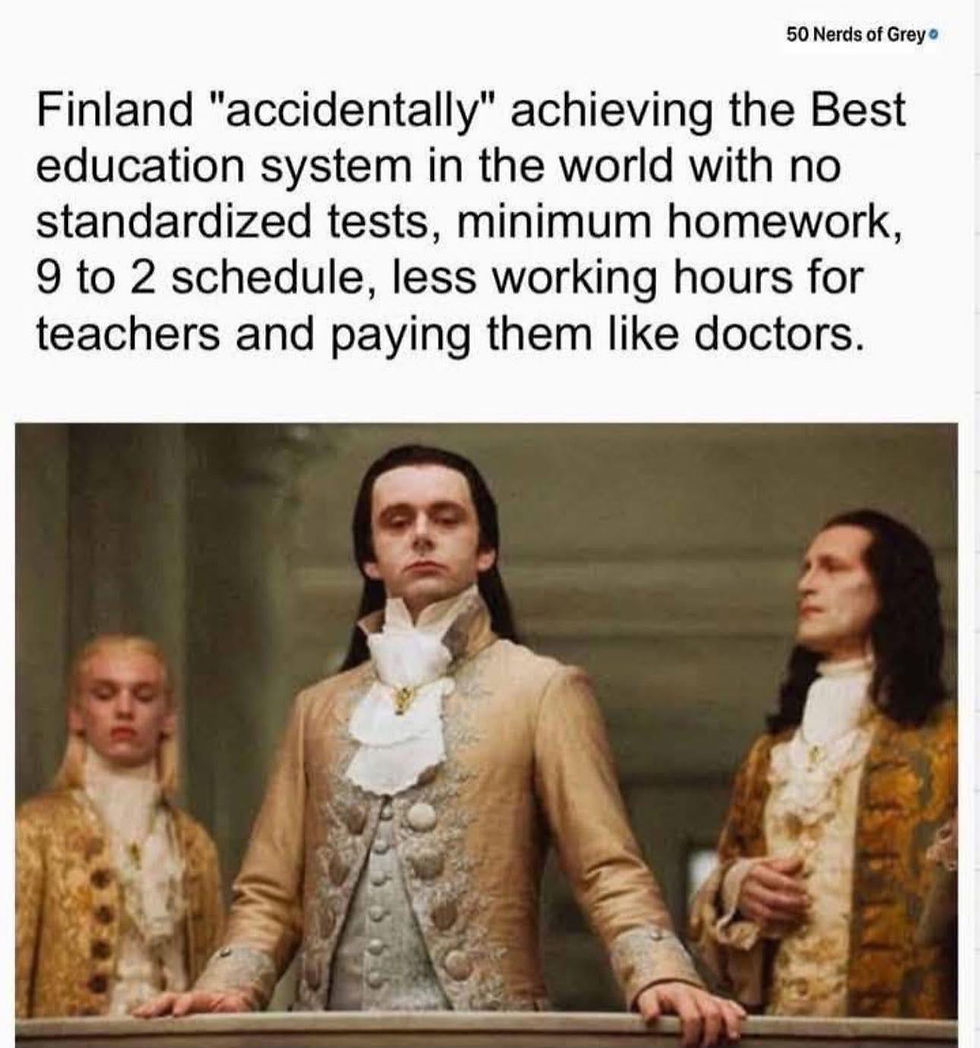Was Finland’s Educational Success an Accident – or the Perfect Design?
- Jun 16
- 3 min read

A few different versions of this meme have been making the rounds recently, claiming Finland “accidentally” created the world’s best education system – one with no standardised testing, minimal homework, short school hours, reduced teacher workload, and salaries that reflect professional respect. It’s humorous, but it raises a powerful question:
Was Finland’s success a lucky fluke, or the result of a system purposefully designed around values, pedagogy and trust?
1. A System Built on Purpose, Not Performance
To call Finland’s educational success an accident is to ignore decades of intentional reform. Since the 1970s, Finland has rebuilt its education system around equity, teacher professionalism, and student wellbeing. These aren’t accidental outcomes; they’re the result of a national commitment to designing for the kind of society it wants to create.
The system deliberately rejects many of the traditional levers used elsewhere, high-stakes testing, standardisation, rigid curricula, and replaces them with trust, autonomy and depth.
2. The Early Years: Play as Pedagogy
Children in Finland begin formal schooling at age seven, one of the latest starts globally. But their learning doesn’t start late, it starts differently.
Before this, children attend high-quality Early Childhood Education and Care (ECEC) programs focused on:
Play-based learning
Social and emotional development
Self-regulation and creativity
Exploration and movement
Learning in these early years is child-centred, inquiry-rich, and deliberately non-academic. Rather than rushing into literacy and numeracy, Finnish educators believe in letting children develop holistically before introducing formal instruction.
This approach doesn’t hinder academic outcomes; it amplifies them, setting a strong foundation for lifelong learning.
3. Pedagogical Freedom and Deep Learning
As students move into primary and secondary education, Finland’s approach remains grounded in trust and autonomy:
There is no standardised testing until the very end of secondary schooling (the matriculation exam)
Assessment is formative, teacher-led, and focused on descriptive feedback
Classrooms are guided by student voice, agency, and real-world connection
In recent years, Finland introduced phenomenon-based learning, an interdisciplinary approach where students explore complex, real-world topics (like climate change or migration) across subject areas. This encourages:
Critical thinking
Collaborative inquiry
Transfer of learning across disciplines
Teachers aren’t delivering content; they’re designing learning experiences, co-constructed with students and responsive to context.
4. Teachers as Experts, Not Technicians
One of the cornerstones of Finland’s education model is the professional status of teachers:
All teachers must complete a research-based master’s degree
Entry into teacher education is highly competitive, with only top candidates accepted
Teacher training includes pedagogical theory, practical placements, and education research, including a thesis
This level of preparation means teachers are trusted as curriculum designers, assessors, and decision-makers. There is no national inspection regime and no punitive accountability structures, because the system is built on trust and expertise.
Teachers also benefit from:
Reduced teaching hours compared to many other countries
Ample planning and collaboration time
Well-compensated roles, often on par with other respected professions like doctors or engineers
A strong culture of professional learning and reflection
5. School by Design, Not By Default
Other structural choices also reflect intentional design:
Shorter school days, typically from 9am to 2pm
Frequent breaks,15 minutes after every 45-minute lesson
Minimal homework, especially in the primary years
Free, healthy school meals for every student
Multi-professional support teams, including psychologists, nurses, and social workers, are embedded in schools
These choices are not indulgent; they are strategic. The Finnish system is built around a belief that learning happens best when students are well, motivated, and supported, and when teachers are treated as experts with the time and freedom to do their work well.
6. Not an Accident... a Blueprint
Finland didn’t achieve world-class outcomes by measuring, testing, or micromanaging its way there. It did so by designing a system that aligns with its values:
Equity over competition
Trust over compliance
Wellbeing over pressure
Deep learning over shallow performance
It’s tempting to dismiss Finland’s success as “unrealistic” or “too different to compare.” But perhaps the real challenge is that it dares us to ask:
What if we designed with the same clarity of purpose?
What if we trusted teachers, centred students, and built schools that prioritised flourishing over ranking?
Final Thoughts
Finland’s success isn’t an accident; it’s the result of decades of deliberate, values-driven design.
No system is perfect, and not everything is directly transferable. But Finland offers a powerful provocation: when we stop designing for control and start designing for growth, learning thrives.
Maybe the question isn’t “Why is Finland different?”
Maybe it’s “Why aren’t we?”
.png)



Comments